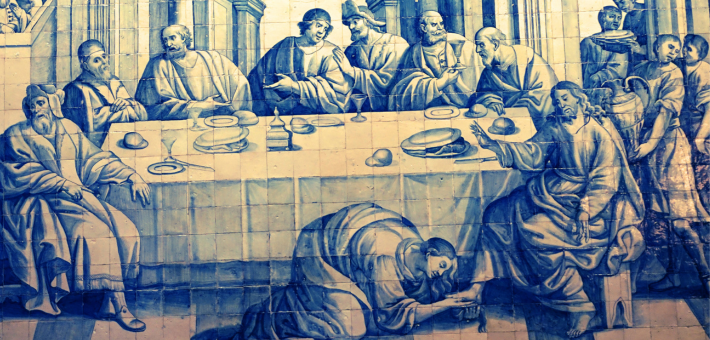Commentary on John 12:1-8
The opening scene in John 12 boldly claims the enduring power of life and love in the face of death and hostility. The author is careful to name all three siblings at the heart of the previous chapter: Mary, Martha, and the formerly dead Lazarus. The anticipated stench of death in chapter 11 is now replaced with the extravagant perfume of Mary’s grateful devotion. But death is not yet finished. The leaders are plotting to kill Jesus (11:45–53). They are also planning to put Lazarus back into a tomb (12:9–11). Surrounded by these movements toward death, we find this celebration of the life that Jesus has given.
Mary’s actions are the center of attention here, but we should not ignore the other siblings. Martha is described as “serving,” as a disciple of Jesus should (12:26). Lazarus is described as “reclining” with Jesus at the table, a description that reappears in 13:23 to describe “the disciple whom Jesus loved” at the last meal. All three siblings have been transformed by Jesus into faithful disciples. Yet it is Mary’s action that is the focus of wonder and scandal. She is at Jesus’ feet as she was in 11:32, but the grief (and anger?) of that previous scene is now replaced with overflowing gratitude.
One of the challenges of preaching this passage is that hearers and preachers may confuse it with accounts from the Synoptic Gospels. The author of this Gospel seems to have known and drawn on other stories about a woman anointing Jesus, but we need to be careful not to conflate this story with similar scenes in the other Gospels:
| Matt. 26:6–13 | Mark 14:3–9 | Luke 7:36–50 | John 12:1–8 | |
| Place: | Bethany | Bethany | Galilee | Bethany |
| House: | Simon the Leper | Simon the Leper | Simon the Pharisee | Lazarus |
| Anointer: | woman | woman | sinful woman | Mary |
| Anointed: | head | head | feet | feet |
| Used: | ointment | ointment of nard | tears and ointment | ointment of nard |
| Dried: | tears with hair | ointment with hair | ||
| Objecting: | disciples | “some people” | Simon, Pharisee (not about cost) | Judas |
Except for the story in Luke, all these accounts include Jesus declaring that this anointing has been for his upcoming burial. This claim takes on an added dimension in John’s account because Jesus has just raised Mary’s own brother from the tomb, undoing that burial. Without denying the reality of the upcoming death, Mary’s presence here also points to the upcoming resurrection. She knows the brutality of death, but she also knows that the grave cannot hold against Jesus.
It is a bit surprising that Mary anoints not Jesus’ head (as in Matthew 26:7 and Mark 14:3) but his feet. As Culpepper notes, Jesus will enter Jerusalem as the Anointed One, but anointed not on his head, as was expected for a king, but on his feet. He is anointed not by the high priest but by a woman.1 Jesus’ entry into Jerusalem and his identity as Messiah will not fit neatly into any preconceived expectations.
Even though Mary’s action here is not described as “washing” Jesus’ feet, we should see her as an image of the discipleship and the love that Jesus will model and command for his followers as he washes their feet in John 13. The verb for “wiping” the feet is used in John to describe only these two scenes (12:3; 13:5). Mary engages in this kind of service even before the command is given. “The power of the witness of Mary’s discipleship in this story is that she knows how to respond to Jesus without being told. She fulfills Jesus’ love commandment before he even teaches it.”2
Mary pours out about a year’s salary onto Jesus’ feet. She pours it all out, withholding nothing. Indeed, there is so much ointment that she needs to soak some of it up with her hair. No wonder Judas is shocked by the “waste.” Mary has to remove some of the very expensive ointment that she had just poured out. She does not put it back into the bottle but will now carry her act of discipleship with her on her own body.
Mary is the image of faith just as Judas is the image of unfaithful deceit. On the surface, Judas seems to have a good point. He taps into the deep biblical concern for the poor, but the author indicates that Judas does this only because he would like to line his own pockets with some of those denarii. It would not be difficult to come up with current examples (religious, political, and commercial) of those who claim to be on the side of the poor while actually siphoning resources away from them. In the end, even characterizing Judas as a thief is not enough for this Gospel writer to account for his betrayal of Jesus, though it does point us ahead and prepare us for how the devil will possess Judas and set in motion that act (13:27).
Too often Jesus’ reply to Judas in verse 8 has become an excuse for not trying to do more (or anything at all) to alleviate poverty or help the poor. That is hardly Jesus’ point. If Judas cares so much about the poor, he will have plenty of opportunity to show that with the same kind of surprising dedication Mary has shown to Jesus. The same is true for us (note that the “you” in verse 8 is plural). Yet such work can often seem futile. How can our meager efforts work any real change?
Mary may lead the way for us. Her action had greater meaning than she probably realized. It was loving and extravagant, but its meaning is finally given by how Jesus takes it up and makes it a part of his own mission. Because of the life that is ours through Jesus’ death, our actions too may be taken up into God’s purposes and so be filled with worth and meaning beyond the waste they sometimes seem to be.


April 6, 2025